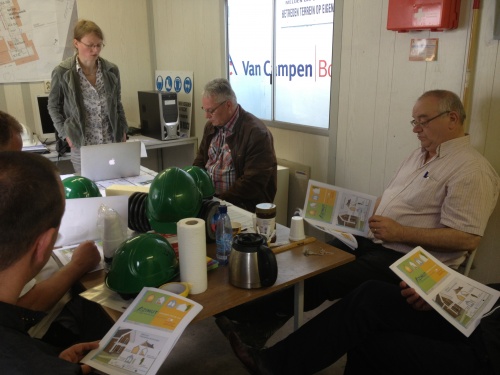Training in a shadow team
The “Shadow team”- approach is a practical method to share hands-on knowledge about the building praxis of NZEB based on Passive House technology combined with renewable energy in all the phases of a real project at all the aspects. The goal of a “shadow team” is literary to “look over the shoulder” of a building team.
The organisation of a shadow team is easy. All you need is a pool of colleagues who are eager to learn more about NZEB’s, a real NZEB-project with a building team that doesn’t mind to be “shadowed” and someone from that team who is willing to provide information about the process of the real project.
Just before a team starts working on a real NZEB-project you form the “shadow team” out of this pool. The maximum size of the “shadow team” is 8 members (6 is preferable). Depending of the members of the “shadow team” and the specific aspects of the real NZEB-project, a focus on specific themes could be made, for example on the technical design aspects or on decision making during the process of the project. However the “shadow team” will follow the real team closely; what are they doing, why, when and how?
To do so, you organise several meetings during the process of the real project. These meetings have the character of a workshop whereby the members of the “shadow team” also have an (limited) active role by doing some work by them selves. Off course, the “shadow team” is not supposed to do the same amount of work as the real team: participating in a “shadow team” is just training. A committed person from the real team informs the “shadow team” about the specific phase of the project and what they are doing, why and how. The members of the “shadow team” can react on that. The real team also can distribute a small task to the “shadow team” to work on it themselves, to learn to solve a specific problem. Allowing the “shadow team” getting involved into a “problem” can lead to interesting solutions that even can be helpful for the real project.
Programme
In general five meetings will do:
1. The first meeting is to form the “shadow team” and provide information and agree on the focus. The team is briefed (fact sheets) about the real NZEB-project and the specifications of the client. You can also invite the client of the project to tell the team what she/he or his/her company consider(s) to be important about the project.
2. The second meeting focuses on the draft design and the context (in terms of important actors and factors) of the project. The team is briefed about the process and design, the problems solved etc. In this stage the members can be given a specific design task to work on by themselves. They even could organise one or more meetings themselves to get the task done.
3. In the third meeting the “shadow team” is presenting their task to (a part of) the real team. The real team evaluates this and provides feedback. Next to this the team is briefed about the final design and problems that have occurred and solutions.
4. The fourth meeting is at the building site itself (tour). The team is briefed about the project again now concentrating on the process and problems solved in the constructing phase. During this meeting you could invite some important stakeholders of the project, for example the municipality involved, to inform the members about her/his role in the process and what her/his opinion is about the project.
5. The fifth and last meeting is also at the project itself (tour) just before delivery of the project (before the blower-test). The team is briefed about this phase of the project and the project and team is evaluated.
The meetings could take place in the evening (19.00 – 22.00). The organisation takes about 4 hours per meeting. In our experience the members of the real team spend their time for free because they consider it important to disseminate their knowledge and experience, certainly if we use their precious time as effective and efficient as possible.
